Friendship and the Internet
Many American youth say that Internet communication, especially instant messaging, has become an essential feature of their social lives. For them, face-to-face interaction and some telephone conversations have been partially replaced with email and instant message communication. Relationships that once might have withered are now nourished by the ease and speed of instant message exchanges and email messages. Romantic relationships are begun and ended online. Difficult conversations with friends are now mediated by the emotional distance the Internet provides. Intimate conversations sometimes seem easier than those that take place face-to-face. Teens say this can be very helpful, especially in otherwise awkward situations or at times when they are too shy to speak. Conversely, relationships with friends and romantic partners are sometimes hurt or destroyed because of misunderstandings sparked by the very voiceless aspects of Internet communication that make it attractive to youth.
Strengthens friendships
About half of online teens (48%) believe that the Internet has improved their relationships with their friends. Frequent users of the Internet are more enthusiastic about the friendship-enhancing quality of the Internet – more than six in ten say that it helps “some” or “a lot.” But some teens, while they appreciate the ease of communication over the Internet and its ability to help them keep in touch with a larger group of people, also recognize that it may not be the best medium for starting or maintaining deeper relationships. “Unless you know the person really well, they’re just some anonymous typist hiding behind a funny screen name,” said one 17-year-old boy from Maryland in an email exchange with the Pew Internet Project. “I don’t see people at school and think that’s somebody I know from AOL. I would not even recognize them and times that I do…it’s ‘Hey, there’s HAPPYKID113.’ The Internet has helped me socialize with more people, but at a very unpersonal level.”
Time with friends: A modest impact
America’s youth do not believe the Internet takes much time away from friendships. Some 61% of online youth say teens’ use of the Internet does little or nothing to detract from the time teens spend together, while only 10% say it takes away a lot of time they think young people would otherwise be enjoying in the company of their friends. Some who say that use of the Internet takes time away from friends argue that this is balanced by the increased level of communication young people have with friends who live too far away for regular face-to-face meetings. “If the Internet did not exist at all, I would probably be out doing things with my friends or getting homework done,” maintained one girl, 17, in the Greenfield Online group discussion. “I think that would be better in some ways, but I think I’d miss out on a lot, especially on keeping in touch with far away friends.”
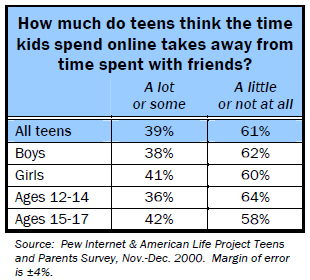
Good for meeting people, not that great for making new friends
Most teens do not believe that the Internet is particularly helpful in making new friends. Sixty-seven percent of all online teens think it only helps “a little” or “not at all” when trying to make new friends. Younger children are more likely than older children to be enthusiastic about the Internet’s capacity to help them make new friends. Some 37% of younger teens say the Internet helps them meet new friends, compared to 29% of older teens who say that. Girls aged 12 through 14 are the most enthusiastic about the Internet’s capacity to help them make friends online.
[online]
A teen’s “true self”
[the]
To others, appearance still matters a great deal. “I continued to chat with these two girls for a long time,” says one boy, 15, in the Greenfield Online group. “Then when I met them…they did not look like what I expected. I thought they would be cute, but they weren’t. After meeting our online and offline friendships died off.”
Research by Elisheva Gross of UCLA and others suggests that teens with strong social connections tend to look to email and instant messaging as a way to reinforce pre-existing bonds, while teens with smaller or less developed social networks look to the Internet to find new companions and social ties to fill-in for the ties they lack offline.10 “I’ve always been very shy in real life,” noted one boy, 16, in the Greenfield Online group. “I’m home-schooled, and have avoided most contact with children my own age. The Internet has, in many ways, replaced real-life socialization for me. This is abnormal, but I don’t think its ‘bad’ by any means. I’ve become comfortable with socializing both on-line and off and I’ve made a large number of friends by participating in small on-line communities.”
Multiple identities: Experimentation and self-protection
Fully 56% of online teens have more than one email address or screen name and most use different screen names or email addresses to compartmentalize different parts of their lives online, or so that they can experiment with different personas. Boys more often than girls report having multiple email addresses or screen names. Sixty-one percent of boys have more than one address – almost a quarter have four or more. Half of online girls (50%) have more than one screen name or email account and nearly one in five girls have more than four online identities. The oldest boys (15 to 17) are the most likely to have more than one address, with two-thirds reporting multiple addresses. The most active Internet users are the most likely of all to have multiple addresses.
Of those teens with multiple addresses, nearly one-quarter say that at least one of those addresses is a secret address that teens use when they do not want their friends to know that they are online. More boys than girls have secret addresses and older teens are more likely to report a secret address than younger teens.
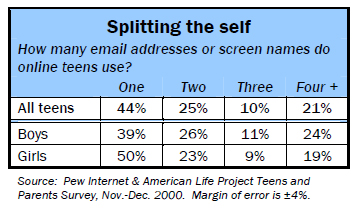
Ann Hird writes in her book Learning from Cybersavvy Students about a particular student with multiple screen names. “Through his choice of screen names, Colin controls the size of the online space in which he functions at any given time. The name ‘Cal Zenkow’ exposes him to online interaction with a large number of other individuals. The second screen name ‘Doctor Topper,’ allows him to maintain a private space accessible only to his five closest friends. Neither screen name has any connection to his offline identity.”11 Says Colin himself, “’Doctor Topper is a screen name I go to sometimes when I want to be left alone.’” Hird also maintains “The Internet provides adolescents with safe spaces for continual modification of the identities they wish to convey to others.”12
For some teens, the possibility of exploring who they are, who they might become, and how they present themselves to the world in fairly safe online environments is a valuable opportunity and a primary use of the Internet. For others, identity play is something in which they dabble while they play jokes on others, but it is not a serious aspect of their Internet use.
[pretended to be someone else]
Meeting strangers
Many teens with Internet access have been contacted by strangers and the majority of them respond at least some of the time. Fully 60% of all online teens have gotten an email or instant message from a perfect stranger and 63% of those who have gotten such emails or IMs say they have responded to strangers online.
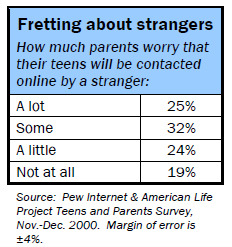
Overall, 50% of those who use instant messaging, email or chat rooms have corresponded via IM or email with people that they have never met face-to-face. However, in many cases, these online conversations involve people who have been introduced by their friends or family members. Still, many are not shy about meeting true strangers online, including those they meet in other places online or the complete strangers who have sent them email or instant messages out of the blue. A 14-year-old girl in the Greenfield Online group discussion reported: “Around half of my buddy list13 are friends I made online. One girl I met in a chat room, we had a lot in common and talked together for almost 3 months and then decided to meet. We did and it was the best. We talked forever and now we see each other a lot.”
Boys and older youth are more likely to have emailed or instant messaged a stranger than girls and younger teens. Fifty-four percent of boys have ever done this compared to 46% of girls. Fifty-seven percent of older teens say they have done this compared to 41% of teens ages 12-14. Predictably, youth who are online every day report doing this more often, with 57% saying they have ever emailed or instant messaged someone they have never met face to face.14
[public place for listing hobbies and other personal information]
Sharing passwords
For some wired teens, a sign of true friendship is for one Internet user to share his screen name and password with a buddy. More than a fifth of our respondents (22%) who use instant messaging, email or chat report sharing their passwords with friends or others that they know. Boys and girls report in equal measure that they do this.
[share my password]
Youth and instant messaging
Almost three-quarters of online teens (74%), roughly 13 million youth, have used an instant messaging program that allows those online to hold conversations back and forth with other users instantaneously. In comparison, 44% of online adults have tried instant messaging at one time or another.
Many online teens use IM frequently. More than 1 in 3 of those who use IM services (35%) say they instant message every day, with another third using instant messaging a couple of times a week (34%). No matter how frequently they log on, 45% of online teens who have used instant messaging say they use this online communications form each time they go online. Close to half (46%) of these young instant messagers say they spend between half and full hour on instant messaging each time they do IM, and another 21% say they spend more than an hour on a typical session.
[who]
Who sends instant messages
A greater proportion of online girls than online boys have ever tried instant messaging – the figures are 78% for girls and 71% for boys. And the percentage of online teens who have used IM increases with age.
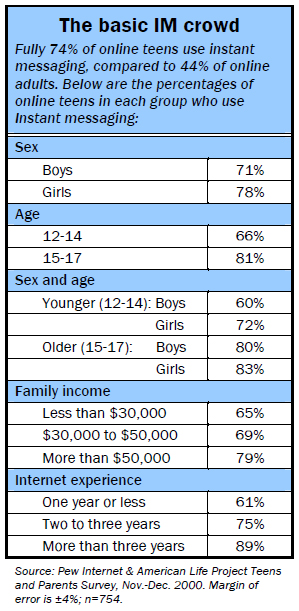
In addition, girls latch on to instant messaging at an earlier age, with 72% of girls 12 to 14 using the service, compared to 60% of boys the same age who use IM. However, boys seem to catch up to girls as they get older, instant messaging at about the same rate as girls by the time they are in high school.
More youth from wealthier families use instant messaging than those from lower income families. Experience online also is closely associated with use of instant messaging. The longer a teen has been online, the more likely she is to use instant messaging.
Instant messaging compared to the phone
Ninety-four percent of online teens in our sample report using online communications tools like email, instant messaging, and chat rooms. Still, a strong majority of online youth (71%) who use these online tools say the phone is still the way they most often get in touch with their friends. At the same time, however, a fifth of these online teens (19%) say that instant messaging is their primary way of communicating with their friends and another 8% report that they use email the most often to contact pals.
When asked why they used one method of communication over another, the teens who cited the telephone say they preferred it because nuances of communication are easier to detect. They like the fact that they can hear emotions on the phone and that means they think they make fewer social mistakes on the phone than they do on the Internet. “Online, it is difficult to convey attitudes or tone of voice, whereas on the phone, there is much more of a human aspect, less austere and sterile than cyberspace,” wrote a 16-year-old girl in an email to the Pew Internet Project.
Others preferred instant messaging for the way it enables multiple simultaneous conversations, and even multiple activities. “I send/receive instant messages almost every time I am online. I talk to up to 8 people at once,” said a girl, 16, in an email to the Pew Internet Project. “I carry on separate conversations with each person. That way, you can talk about more stuff at once.”
The special character of instant messages15
Teens report instant messages do not contain the visual and aural cues that people get in face-to-face or phone contacts. They say this can lead to misunderstandings. “Although it never really starts anything big, I do frequently misunderstand people online, and they misunderstand me,” said one boy, 16, in the Greenfield group. “It is hard to convey tone of voice and the manner in which one is saying something online. Sarcasm can be easily misunderstood online.” At the same time, though, online teens appreciate instant messaging because they say it gives them a greater freedom to craft arguments carefully or to word an unpleasant message delicately.
Fully 37% of instant message-using teens say they have used IM to say something that they would not have said to somebody’s face. They report feeling a measure of protection using IM because writers cannot see the first reaction of the recipient. “It is easier to talk to someone about certain topics online, than to talk about them face-to-face,” reported a 17-year-old girl in the Greenfield Online group discussion. “Online you can think things over, and erase them before you look stupid, rather than to their face, where you can’t always take things back.”
[online]
When online arguments are not resolved quickly, or when strangers or others send irritating or incessant instant messages, IM users often use the tools at their disposal to protect themselves. Fifty-seven percent of instant message users say they have blocked an instant message from someone they did not want to hear from. And 64% have ever ignored an instant message from someone they were mad at or did not like.
Dating
Significant numbers of teens have used instant messages to conduct relationships: 17% of IM users have asked someone to go out with them with an instant message. Teenage boys, especially those between ages 12 and 14, are the most likely to have used instant messages this way. One quarter of instant message-using boys have asked someone out over an instant message, as have 10% of IM-using girls. “She and I started to talk online and played a game where we could ask each other anything,” wrote one 16-year-old boy in the Greenfield Online group discussion. “I eventually asked her out…online, of course. It’s not the most romantic thing to do, but I was very nervous and it helped to make it a little bit easier.”
Some 13% of IM users have broken up with someone via an instant message. There are not gender-based differences in this use of instant messaging. An equal number of girls and boys have used IMs to break up with someone. Younger teens (ages 12-14) are more likely than older teens to use this form of communication to end a relationship. Almost a fifth (18%) of teens in this age bracket have done so.
At times, even the emotional core of a relationship is conducted through instant messages and email. “Sometimes it is easier to say what is in your heart online,” noted a girl, 17, in the Greenfield Online group discussion. “You can type the words and hit send instead of freezing up in person. In the mornings I sometimes get love letters and it makes me feel so good. I love hearing what my sweetie is thinking.”
Making Plans
Eighty-two percent of online teens use instant messages to make plans with their friends. “We can check movie times online and get directions for where we want to go and have everyone talking and checking with each other at once,” said one 17-year-old girl in the Greenfield Online group discussion. “That’s really great because it makes things so much easier.”
Pranks and deception
Instant messages and emails have become a prime vehicle for playing tricks on friends or others. A little more than a quarter (26%) of instant messaging teens have used the medium to pretend to be someone different. “Unfortunately, a friend and I tricked someone once,” reported a 16-year-old boy in the Greenfield Online group discussion. “This person was a friend of mine (I’ll call him ‘Jim’). We created a new screen name and told ‘Jim’ that we knew his address and phone number and stuff. It only lasted about 15 minutes, but it really did mess up our friendship. I did it all in fun, but ‘Jim’ took much offense to it, and I can understand why. I decided not to mess with online trickery any more. Another time, another friend of mine created a new screen name and IM-ed his girlfriend to see if she was being faithful.”
Online deception concerns some teens enough that they only use email and instant messaging with people they already know. But many just assume it is part of the online environment and cope in other ways. “I don’t think people are always completely honest but it’s not a big problem,” wrote a 17-year-old boy in an email to the Pew Internet Project. “They’re mostly small, white lies that are of little consequence.” Added a girl, 13, in another email: “Yeah, I think people give a lot of fake info online all the time. Yeah, I guess I worry about it because of my friends’ safety. They talk to people they have no idea who they are and sometime I find myself telling them that it might not be the person who they think it is. Of course, they think I’m a stiff @$$, but its ok as long as they’re still living. Some of my friends think they’re talking to Justin from N’sync, but I don’t think so. There is so much information about him that anyone can impersonate him. I think it’s quite scary.”
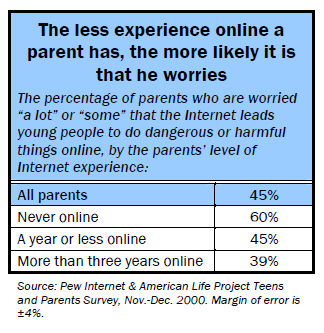
Chat room tricks
Online teens also recognize that chat rooms are places where deception is commonplace. There is a sense among many teens, particularly younger ones, that chat rooms are dangerous places. According to online teens, one of the most common questions a new arrival in a chat will be “ASL?” That is a request from another chat participant asking someone her Age, Sex, Location.
One 15-year-old girl said in an email to the Pew Internet Project that she thought that people online lied about who they were, but that it did not worry her because “people ought to know if they go into a chat room what risks go along with it, and you have to know that you can’t trust anything anybody tells you.” And another 16-year-old girl added: “I rarely go into chat rooms, if ever, and while there, I’m not looking for a faithful friendship so it’s not like I am expecting to trust them completely.” A common refrain is highlighted by one 14-year-old girl, who wrote in an email to the project: “I used to go into chat rooms, but I don’t anymore.”
[But]




